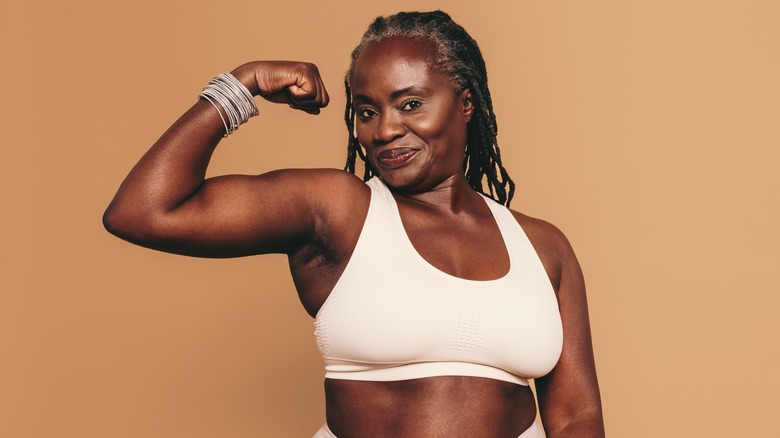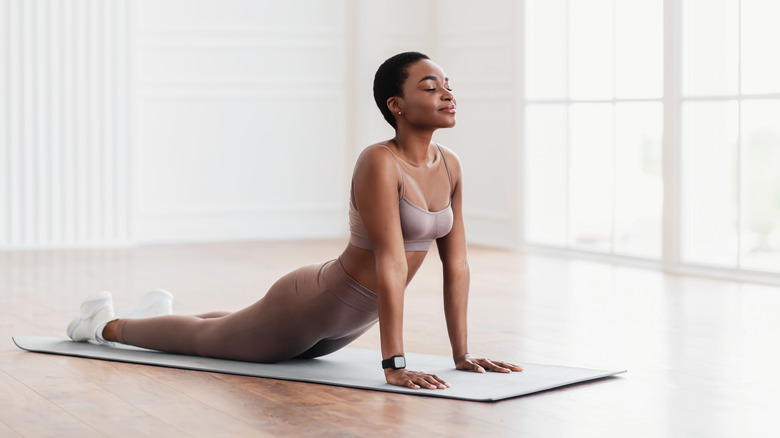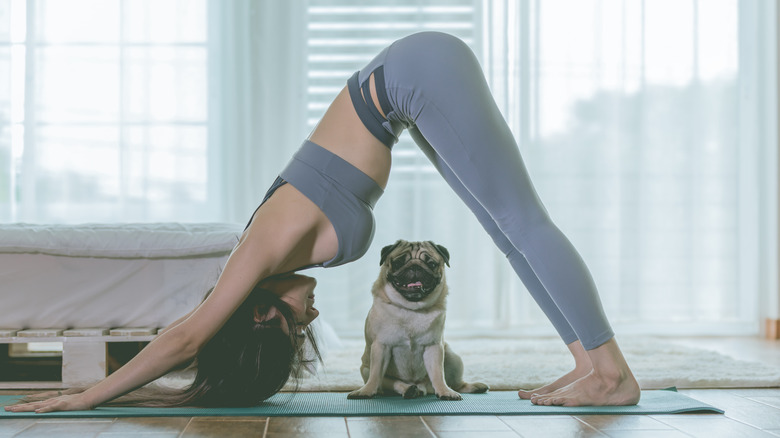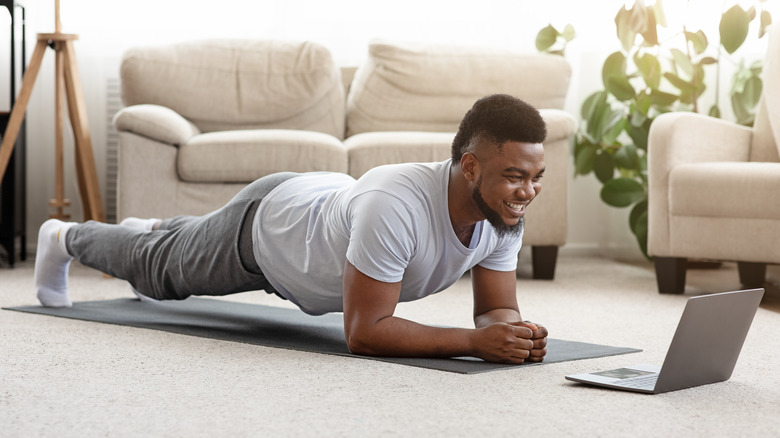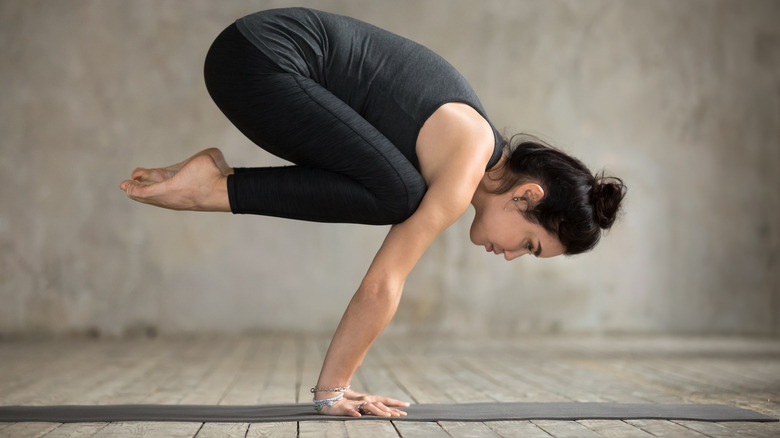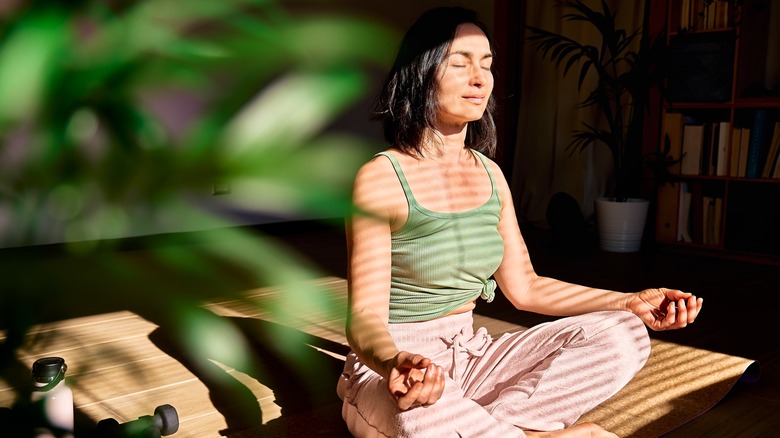The Best Yoga Moves For Strengthening Your Arms
Yoga is a great way to build strength because it involves the use of your own body weight to provide resistance against gravity (via Healthline). If you're looking to build strength in your arms, many yoga poses require you to engage your muscles as you hold your body in different positions. This can help build strength and maintain proper form. In addition to strengthening specific muscle groups, yoga can also help to improve overall body strength, stability, and balance, per Johns Hopkins Medicine. This might be because many yoga poses require you to maintain balance and control as you move through different postures.
Overall, regular yoga practice can help to increase muscle strength and endurance, says Healthline. Speaking to your doctor before engaging in intense exercise is important. Also, remember to listen to your body, especially if you're new to yoga or have any injuries or limitations. With regular practice, your strength and stability might improve over time.
Upward-facing dog
Upward-facing dog, or "urdhva mukha svanasana" in Sanskrit, is a pose that strengthens the arms, per Yoga Journal. To begin the pose, Yoga Journal advises to first lay on your stomach with your feet hip-width apart and your toes pressed into the mat. Place your hands on the mat beside your ribcage, with your fingers spread wide and your palms flat on the ground. Press into your hands to lift your head and chest off the ground, keeping your hips and legs on the ground. Your shoulders should be back as you lift your chest higher.
In the upward-facing dog, you should feel a stretch through your chest, shoulders, and arms, as well as your abdominal muscles, according to Yoga Jala. Keeping a proper alignment is important to avoid straining your lower back or shoulders. It is also a good idea to consult with a qualified yoga instructor if you have any concerns or are new to this pose.
Downward-facing dog
According to Boston University, downward-facing dog, also known as "adho mukha svanasana" in Sanskrit, is an inversion, which involves reversing the body's natural spinal alignment. The International Sports Science Association (ISSA) advises starting the pose in a tabletop position on your hands and knees. Make sure that your hands are directly under your hips. Keep your fingers apart and press down through your palms and knuckles. Next, position your toes under and lift your hips up and back, straightening your legs as much as possible. You should be in an inverted V shape at this point with your toes pointed and feet shoulder-width apart. Make sure to keep your core engaged and your shoulders away from your neck, says the ISSA.
The benefits of practicing downward-facing dog are plenty. In addition to strengthening the arms, it stretches the entire back body to release tension, according to the ISSA. On top of this, inverting the body can help improve circulation and relieve stress.
Plank pose
The plank pose, also known as "kumbhakasana" in Sanskrit, is often used as a foundational pose in many yoga practices. It is a static pose, meaning that it involves holding a position for an extended period of time, according to Physiopedia. The plank pose is a great pose for building overall body strength, as it works many different muscle groups at once. According to Healthline, plank exercises, in general, can help to build strength and stability in the core, lower body, and upper body. And as the Yoga Journal explains, it can also help to improve posture, as well as increase mind-body awareness.
To begin the pose, Yogapedia advises starting in a tabletop position with your knees and hands on the mat. Ensure your wrists are directly under your shoulders to form a straight line with your arms. Step your feet back one at a time so that your entire body from head to toe is in a straight line, similar to a push-up position. For a stronger plank, the Yoga Journal advises engaging your core to keep the pose in place.
Crow pose
Crow pose, also known as "kakasana" in Sanskrit, can be challenging and may take some time to master. It requires strength, stability, and balance, and it can help to build strength in the arms, wrists, and core (via the Yoga Journal). To begin the pose, start in a squatting position with your feet apart and your hands on the ground in front of you. Shift your weight forward on your feet's balls and lift your feet off the ground. Bring your torso as close to your shoulders as possible, and you can also balance your knees on your triceps. Hold the pose, taking deep breaths 5-10 times.
As mentioned, crow pose can be quite challenging — it's important to consult with your doctor before engaging in strenuous exercises, especially if you have any injuries. It also helps to listen to your body, especially if you're new to yoga. Overall, it's important to approach your yoga practice with a focus on consistency and patience rather than trying to rush results.
The benefits of practicing yoga to strengthen your arms
In addition to physical changes, many people also experience mental and emotional benefits from practicing yoga, says Medical News Today. These can include reduced stress and anxiety, improved sleep, and increased feelings of relaxation. Another benefit of yoga is that it can be modified to meet the needs and abilities of each individual. Depending on the pose, yoga can be an accessible and effective form of exercise for people at any fitness level.
How long it takes to see results from yoga can vary depending on several factors, including the postures you engage in, your diet, and your consistency with practicing (via Medicine Net). According to the source, some people see results within 6-12 weeks of starting a regular yoga practice. For others, it may take longer to see these changes. With regular practice, your strength, flexibility, and overall well-being might improve over time.
It's also important to remember that everyone's journey with yoga is unique, and it's okay if you progress at a different pace than others. If you're new to yoga or have any injuries or limitations, it's important to talk to your instructor, who can help you to modify poses and come up with a practice that is safe and effective for you. The most important thing is to find a practice that feels enjoyable and sustainable for you.

